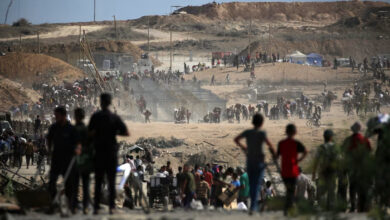Gaza–Two years after Israel’s deadly Cast Lead assault on the Gaza Strip, the besieged territory continues to suffer from unfinished reconstruction work and a failing economy.
Moreover, the heated political situation in the Palestinian territories recalls the 2007 civil war between Fatah and Hamas, during which the Palestinian Authority threatened to take Gaza by force if Hamas did not sign on to an Egypt-proposed reconciliation agreement.
Meanwhile, Israel has stepped up military operations in Gaza over the past two months. On Monday, Israeli fighter jets struck eight targets throughout the strip in ostensible retaliation for a handful of Kassam rockets allegedly fired towards Israel by Hamas.
With conflict looming and the longstanding chokehold on the territory showing no sign of letup, the coastal enclave still bears the scars from Israel’s devastating assault two years ago.
The Cast Lead operation, which began on 27 December, 2008, killed 1404 Palestinians–including children, women and medical personnel–and maimed thousands more. According to the United Nations Relief Works Agency, 2692 buildings were destroyed by the assault, along with 167 kilometers of roads and bridges and 2100 hectares of cultivated land.
Reconstruction work, meanwhile, has been delayed indefinitely–a state of affairs widely blamed on the longstanding siege.
Hamas, which has governed the strip since 2007, has repeatedly said it was doing its best to move rebuilding efforts forward in spite of the limitations imposed by the siege.
In July, a number of Gazans staged demonstrations in front of the UNRWA’s local offices to demand that the agency provide alternative housing for those rendered homeless by Israel’s assault. The UNRWA, for its part, blames reconstruction delays on Israel’s refusal to allow the entry of badly needed construction materials into Gaza.
The scarcity of building materials has not been eased by the system of tunnels connecting Gaza to neighboring Egypt, on which the people of Gaza rely for basic needs, including food and medicine.
“In terms of building materials, what gets into Gaza through the tunnels isn’t enough for any serious reconstruction work,” said Khaleel Abu Daba, a merchant in Gaza.
Israel, meanwhile, says it has eased the siege by allowing more aid shipments to enter the strip–it claims 400 trucks were allowed in this year–and by permitting Gazan farmers to export some of their crops to Europe. Eitan Dangot, chief of civilian affairs in Gaza at the Israeli Defense Ministry, said that 78 civilian projects in Gaza had been approved to date, including hospitals, schools and housing units. Only about half of these, however, have actually begun.
But Israel’s claims about easing the siege are belied by the strip’s deteriorating economic conditions. According to Abo Khader Hassaniya, owner of a local chain of supermarkets in Gaza, the local economy has never been worse. “What’s the point of stocking a market with goods if the people of Gaza have empty pockets?” he asked.




